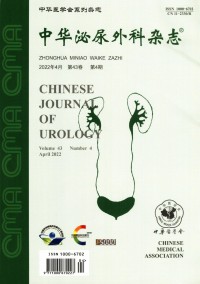基于CT放射组学的肾透明细胞癌世界卫生组织/IUP分级预测模型的建立
Q4 Medicine
引用次数: 0
摘要
目的建立基于CT放射组学的肾透明细胞癌世界卫生组织/ISU分级预测模型。方法回顾性分析2014年3月至2018年12月在陕西中医药大学附属医院经手术或活检确诊的104例ccRCC患者的临床资料。男70例,女34例,年龄61.2±11.7岁。按7∶3的比例分层抽样,将患者随机分为发展队列(73例)和验证队列(31例)。根据世界卫生组织/ISU 2016年癌症病理分级标准,Ⅰ、Ⅱ分为低级别组,Ⅲ、Ⅳ分为高级别组。在CT增强扫描的皮质期图像中计算ccRCC的放射组学特征。LASSO回归用于降低训练组的放射组学特征维度,并建立放射组学风险评分。二元逻辑回归用于建立预测模型,该模型用于验证组。采用Bootstrap方法对训练验证组模型进行验证。分别计算AUC、敏感性和特异性。Hosmer-Lemeshow拟合优度检验用于评估模型的校准程度。结果降维后建立ccRCC的放射组学风险评分。训练组的低风险和高风险评分分别为-2.49±1.73和1.23±2.17,差异有统计学意义(t=-7.785,P 0.05),Hosmer-Lemeshow拟合优度检验良好(χ2=14.554,P=0.068)。结论基于CT放射组学的预测模型对ccRCC的高低分级具有较高的预测精度。关键词:癌,肾细胞;放射组学;病理分级;预测模型本文章由计算机程序翻译,如有差异,请以英文原文为准。
Establishment of WHO/ISUP grading prediction model for renal clear cell carcinoma based on CT radiomics
Objective
A predictive model of WHO/ISUP grading of renal clear cell carcinoma was constructed based on CT radiomics.
Methods
The clinical data of 104 patients with ccRCC confirmed by operation or biopsy from March 2014 to December 2018 in the Affiliated Hospital of Shaanxi University of Traditional Chinese Medicine were retrospectively analyzed. There were 70 males and 34 females, and the age was 61.2±11.7 years. The patients were randomly divided into development cohort (73 cases) and validation cohort (31 cases) by stratified sampling according to 7∶3 ratio. According to the WHO/ISUP pathological grading criteria of renal cancer in 2016, Ⅰ and Ⅱ were defined as low-grade group, Ⅲ and Ⅳ were defined as high-grade group. The radiomics features of ccRCC were calculated in cortical phase images of CT enhanced scanning. LASSO regression was used to reduce the radiomics feature dimensionality in the training group, and to establish radiomics risk scores. The binary logistic regression was used to build the prediction model, which was used in the validation group. Bootstrap method was used to validate the model of training and validation group. AUC, sensitivity and specificity were calculated respectively. Hosmer-Lemeshow goodness-of-fit test was used to evaluate model calibration degree.
Results
After dimensionality reduction, the radiomics risk score of ccRCC was established. The low and high-level risk scores of the training group were -2.49±1.73 and 1.23±2.17, with significant difference (t=-7.785, P 0.05). The low and high-level risk scores of the Validation group were -2.27±2.02 and 0.82±2.08, with significant difference (t=-3.832, P<0.01). The AUC in validation group was 0.859(95%CI 0.723-0.995) with 77.8% sensitivity and 81.8% specificity, and with good Hosmer-Lemeshow goodness-of-fit test (χ2=14.554, P=0.068) as well.
Conclusions
The prediction model based on CT radiomics has high accuracy in predicting high or low grade of ccRCC.
Key words:
Carcinoma, renal cell; Radiomics; Pathological grading; Predictive model
求助全文
通过发布文献求助,成功后即可免费获取论文全文。
去求助
来源期刊

中华泌尿外科杂志
Medicine-Nephrology
CiteScore
0.10
自引率
0.00%
发文量
14180
期刊介绍:
Chinese Journal of Urology (monthly) was founded in 1980. It is a publicly issued academic journal supervised by the China Association for Science and Technology and sponsored by the Chinese Medical Association. It mainly publishes original research papers, reviews and comments in this field. This journal mainly reports on the latest scientific research results and clinical diagnosis and treatment experience in the professional field of urology at home and abroad, as well as basic theoretical research results closely related to clinical practice.
The journal has columns such as treatises, abstracts of treatises, experimental studies, case reports, experience exchanges, reviews, reviews, lectures, etc.
Chinese Journal of Urology has been included in well-known databases such as Peking University Journal (Chinese Journal of Humanities and Social Sciences), CSCD Chinese Science Citation Database Source Journal (including extended version), and also included in American Chemical Abstracts (CA). The journal has been rated as a quality journal by the Association for Science and Technology and as an excellent journal by the Chinese Medical Association.
 求助内容:
求助内容: 应助结果提醒方式:
应助结果提醒方式:


